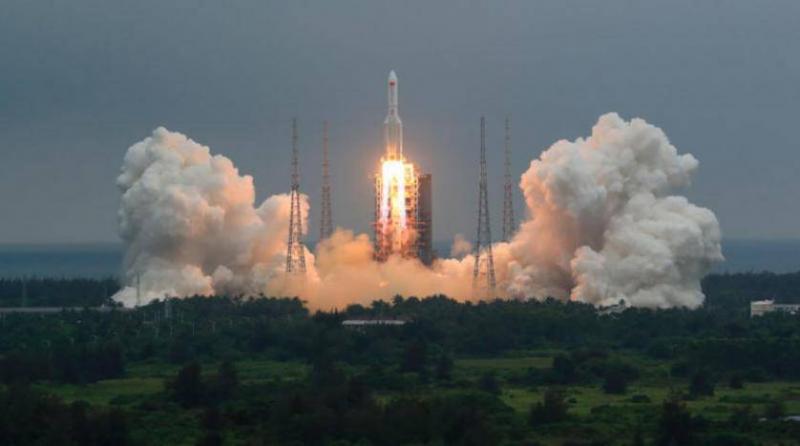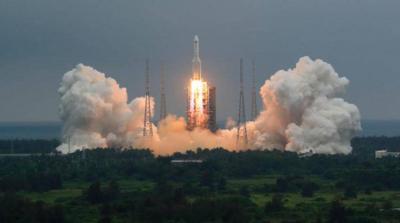Under the title "The 'Lost' Chinese Rocket Hides a Fierce Trade Conflict," the Sharq Al-Awsat newspaper reported on a release from the U.S. news outlet Fox News that suggests the uproar surrounding the Chinese rocket expected to re-enter Earth's atmosphere imminently may be tied to a hidden conflict. This conflict involves China, which is making massive investments in space to undermine the economic and commercial viability of competing U.S. companies.
The report indicated that while the rocket's descent might not cause damage, its landing remains uncertain, particularly whether it will fall onto land or not. However, China's aggressive strategy to reduce the costs of commercial space launches could hurt U.S. businesses. According to Greg Autry, a member of the advisory council for the U.S. Federal Aviation Administration's Commercial Space Transportation Office, China is supporting its private companies by providing them with ballistic missiles for free to eliminate U.S. competitors.
Autry highlighted that the cost of sending one kilogram into space was previously around $40,000. Emerging companies expected prices to decrease to between $25,000 and $30,000. Still, when the Chinese entered the competition, they claimed they could lower the cost to approximately $5,000 per kilogram. He noted that this significant drop in cost is not a simple feat, indicating that prices had fallen by much more than half. Autry concluded that this situation appears to be a strategy to capture the largest market share by slashing prices.
However, experts noted that although China's government has provided its companies with ballistic missiles, these rockets lack the necessary technical equipment, particularly the propulsion systems for maneuvering their paths around Earth's orbit to manage their atmospheric entry and destruction over safe areas. These deficiencies represent technological gaps where China still lags and its efforts to maintain low costs to enhance competitiveness.
Experts suggest that U.S. companies will face fierce competition from China, which launched the first of three components of its "CSS" space station last week using the "Long March 5B" rocket currently adrift in space. The "Long March 5B" rocket lifted off from China's Hainan Island on April 29, carrying the uncrewed Tianhe module, which was intended to house living areas within a permanent Chinese space station. Following its separation from the space module, the rocket began orbiting the Earth in an erratic path, gradually descending and making it nearly impossible to predict where it will re-enter the atmosphere and land.
China insists that the rocket debris will most likely fall into international waters and will disintegrate upon entering the atmosphere. U.S. Defense Secretary Lloyd Austin subtly criticized China, urging countries engaged in space endeavors to uphold international standards to ensure the safety and security of their equipment. He added that the Pentagon currently has no plans to destroy the rocket and hopes it will land in a non-harmful area, such as the ocean.
This comes as SpaceX, led by Elon Musk, has developed its own rockets at high costs, while the startup Phantom Space Corp plans to purchase U.S.-made engines from Aurora Major in Denver. These companies are betting on the growth of space flight commerce, developing multiple rocket systems and spacecraft for missions to the Moon and Mars.
Regarding predictions for the rocket's landing, a U.S. federally funded research and development center stated it is expected that rocket remnants will enter the atmosphere late Saturday or early Sunday morning. The Chinese Ministry of Foreign Affairs stated that most of the rocket debris would burn up upon atmospheric entry, making damage highly unlikely, after the U.S. military mentioned it was monitoring what it described as an uncontrolled re-entry.
In a tweet published Friday night in the U.S., the Aerospace Corporation indicated that the latest predictions from its Center for Orbital Return Studies and Debris (CORDS) suggest the rocket body will enter the atmosphere around 8 hours, give or take, before or after 4 a.m. GMT Sunday. CORDS' latest predictions estimate the entry point of the rocket body will be near New Zealand's North Island, but also noted that entry is possible anywhere along wide paths across the globe.
Jonathan McDowell, an astrophysicist, previously told Reuters that there was a chance pieces of the rocket could fall onto land, possibly in residential areas as happened in May 2020 when parts of the first "Long March 5B" rocket fell on the Ivory Coast, damaging some buildings without reported injuries. The height of the rocket body has been decreasing since last week, but the rate of decline is indeterminate due to unpredictable atmospheric variables. This represents one of the largest pieces of space debris returning through the atmosphere to Earth, weighing 18 tons.




